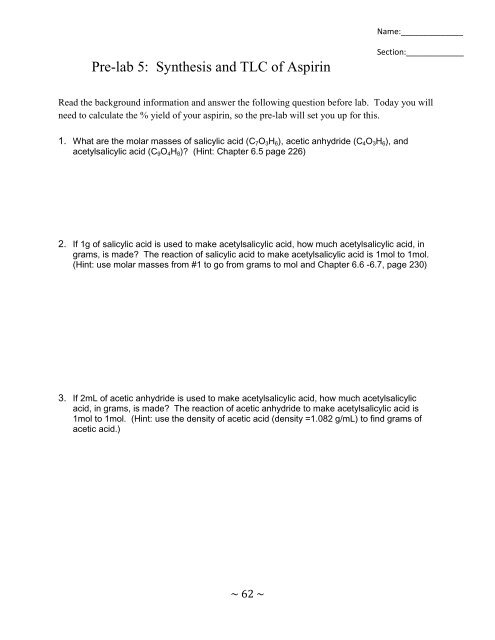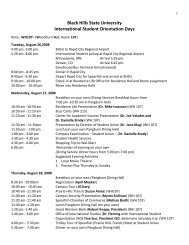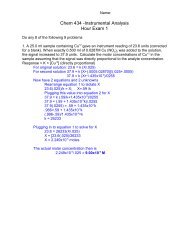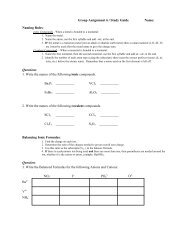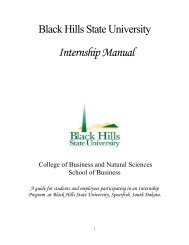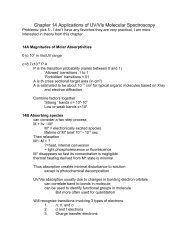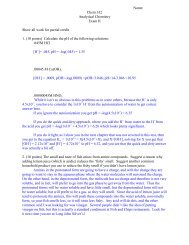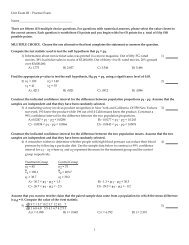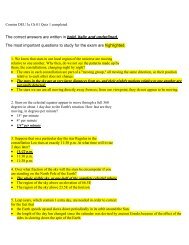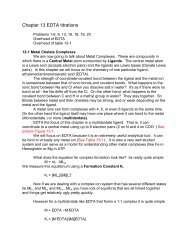Pre-lab 5: Synthesis and TLC of Aspirin
Pre-lab 5: Synthesis and TLC of Aspirin
Pre-lab 5: Synthesis and TLC of Aspirin
Create successful ePaper yourself
Turn your PDF publications into a flip-book with our unique Google optimized e-Paper software.
Name:______________<br />
<strong>Pre</strong>-<strong>lab</strong> 5: <strong>Synthesis</strong> <strong>and</strong> <strong>TLC</strong> <strong>of</strong> <strong>Aspirin</strong><br />
Section:_____________<br />
Read the background information <strong>and</strong> answer the following question before <strong>lab</strong>. Today you will<br />
need to calculate the % yield <strong>of</strong> your aspirin, so the pre-<strong>lab</strong> will set you up for this.<br />
1. What are the molar masses <strong>of</strong> salicylic acid (C 7 O 3 H 6 ), acetic anhydride (C 4 O 3 H 6 ), <strong>and</strong><br />
acetylsalicylic acid (C 9 O 4 H 8 )? (Hint: Chapter 6.5 page 226)<br />
2. If 1g <strong>of</strong> salicylic acid is used to make acetylsalicylic acid, how much acetylsalicylic acid, in<br />
grams, is made? The reaction <strong>of</strong> salicylic acid to make acetylsalicylic acid is 1mol to 1mol.<br />
(Hint: use molar masses from #1 to go from grams to mol <strong>and</strong> Chapter 6.6 -6.7, page 230)<br />
3. If 2mL <strong>of</strong> acetic anhydride is used to make acetylsalicylic acid, how much acetylsalicylic<br />
acid, in grams, is made? The reaction <strong>of</strong> acetic anhydride to make acetylsalicylic acid is<br />
1mol to 1mol. (Hint: use the density <strong>of</strong> acetic acid (density =1.082 g/mL) to find grams <strong>of</strong><br />
acetic acid.)<br />
~ 62 ~
4. Which <strong>of</strong> the answers for #2 <strong>and</strong> #3 is a lower value? The reactant that produced this value<br />
is called the limiting reagent. Is the limiting reagent salicylic acid or acetic anhydride?<br />
5. The lower value in #4 is also called the theoretical yield <strong>of</strong> the reaction. If your experimental<br />
yield was 0.98g, what is the % yield for your experiment? (Hint: Chapter 6.8, page 236,<br />
%yield = (actual yield/theoretical yield) x 100%)<br />
~ 63 ~
Lab 5: <strong>Synthesis</strong> <strong>and</strong> <strong>TLC</strong> <strong>of</strong> <strong>Aspirin</strong><br />
Objective: The objectives <strong>of</strong> this experiment are to make aspirin <strong>and</strong> then use <strong>TLC</strong> to determine<br />
the purity <strong>of</strong> your aspirin.<br />
Background Information:<br />
<strong>Synthesis</strong> <strong>of</strong> <strong>Aspirin</strong><br />
Salicylic acid was once used as a pain killer, but it caused irritation to the stomach lining.<br />
Scientist found that by adding a new functional group to salicylic acid <strong>and</strong> forming<br />
acetylsalicylic acid, the stomach irritation was reduced. The reaction for this is shown in Figure<br />
1.<br />
salicylic acid acetic anhydride acetylsalicylic acid acetic acid<br />
Figure 1.<br />
Over time Acetylsalicylic acid (aspirin) will breakdown into salicylic acid <strong>and</strong> acetic acid. In<br />
order to slow this breakdown aspirin should be stored in a dry place. Today you will look at<br />
aspirin that has been left in water for a little over a week <strong>and</strong> has broken down. You can tell<br />
when aspirin has broken down by the vinegar smell <strong>of</strong> acetic acid. Since acetic acid is also<br />
produced by the aspirin reaction, if the aspirin made today is not rinsed well, acetic acid will also<br />
show up in the aspirin sample.<br />
<strong>TLC</strong> Analysis<br />
<strong>TLC</strong> st<strong>and</strong>s for Thin Layer Chromatography. This is a technique used to look at samples that<br />
may contain multiple compounds in them or determine an unknown when you have multiple<br />
known samples to compare it to. You will be using <strong>TLC</strong> to compare the aspirin that you make to<br />
a commercial aspirin, the starting material (salicylic acid), <strong>and</strong> a decomposed sample <strong>of</strong> aspirin.<br />
~ 64 ~
Procedure:<br />
Data:<br />
<strong>Synthesis</strong> <strong>of</strong> <strong>Aspirin</strong><br />
Equipment list:<br />
Small Vial with Lid<br />
Vial Holder<br />
Thermometer<br />
Ring St<strong>and</strong><br />
Thermometer Clamp<br />
Ice Bath<br />
A) <strong>Synthesis</strong> <strong>of</strong> <strong>Aspirin</strong><br />
1) Place the small vial on the balance <strong>and</strong> tare it.<br />
2) Weigh out about 1g <strong>of</strong> salicylic acid into the vial.<br />
3) Record the exact weight on the blank line. Include units. __________________<br />
4) Record this value on the report sheet also.<br />
5) Add 2 mL <strong>of</strong> acetic anhydride to the vial.<br />
6) Add 0.4 mL <strong>of</strong> sulfuric acid (catalyst) to the vial.<br />
7) Mix the contents <strong>of</strong> the vial by gently swirling.<br />
8) Place a thermometer in the vial.<br />
9) Place the vial in the vial holder. Support the thermometer.<br />
10) Monitor the temperature <strong>of</strong> the reaction.<br />
11) When the temperature begins to decrease, make an ice bath.<br />
B) Set up an Ice Bath<br />
1) Place the vial in a 250 mL beaker.<br />
3) Pack enough ice around the vial to cover the liquid in the vial.<br />
4) The acetylsalicylic acid should begin to form as a solid in the vial.<br />
5) Add 2 mL <strong>of</strong> water to the vial.<br />
6) Filter <strong>and</strong> dry the aspirin using a Buchner funnel.<br />
C) Recrystalize the <strong>Aspirin</strong> (if time permits)<br />
1) Dissolve your aspirin in hot toluene.<br />
2) Allow to cool in an ice bath.<br />
3) Filter <strong>and</strong> dry the aspirin again using a Buchner funnel.<br />
7) Weigh the aspirin.<br />
8) Record the weight on the blank line. Include units. __________________<br />
9) Record the weight on your report sheet also.<br />
~ 65 ~
10) a. What is the theoretical yield for the acetylsalicylic acid? Record the final value on the<br />
report sheet.<br />
b. What is the % yield for your acetylsalicylic acid? Record the final value on the report<br />
sheet.<br />
<strong>TLC</strong> Analysis <strong>of</strong> <strong>Aspirin</strong><br />
Equipment list:<br />
Three- 50 mL Erlenmeyer Flasks<br />
Small Tubes<br />
<strong>TLC</strong> Chamber<br />
<strong>TLC</strong> Plate<br />
Ruler<br />
Pencil<br />
D) Set-up<br />
1) Place a small amount <strong>of</strong> salicylic acid, commercial aspirin,<br />
<strong>and</strong> synthesis aspirin in three separate, <strong>lab</strong>eled 50 mL<br />
Erlenmeyer flasks.<br />
2) Add 5 mL <strong>of</strong> ethanol <strong>and</strong> mix by gently swirling.<br />
3) Wait until the contents <strong>of</strong> all <strong>of</strong> the flasks are dissolved.<br />
4) Obtain a <strong>TLC</strong> plate by h<strong>and</strong>ling the edges <strong>and</strong> not the front.<br />
5) With a pencil, mark 1cm <strong>and</strong> 9cm up the plate <strong>and</strong> draw a line.<br />
6) Make 4 marks on the 1 cm line, 1 for each sample.<br />
~ 66 ~
7) Step 5 <strong>and</strong> 6 are shown in Figure 2.<br />
8) Label on Figure 2, where each sample will go on the plate.<br />
Step 5 Step 6<br />
9cm<br />
1cm<br />
Figure 2.<br />
9) Place each sample you <strong>lab</strong>eled on the Figure on the real <strong>TLC</strong><br />
plate on the marks, using the small tubes.<br />
10) The line 9 cm up the plate will be the stop point.<br />
11) Use the UV light to check that your dots works.<br />
E) Running the <strong>TLC</strong> Platess<br />
1) Put 15 mL <strong>of</strong> the <strong>TLC</strong> solution in the <strong>TLC</strong> chamber.<br />
2) Carefully place the <strong>TLC</strong> plate in the chamber.<br />
3) Put the lid on the chamber.<br />
4) Watch the solution move up the <strong>TLC</strong> plate, until it reaches<br />
the 9cm line.<br />
5) Remove the <strong>TLC</strong> plate from the chamber.<br />
6) Allow the plate to dry completely.<br />
7) Use the UV light to look at the spots on the <strong>TLC</strong> plate.<br />
8) Draw the location <strong>and</strong> <strong>lab</strong>el the color <strong>of</strong> the dots on the <strong>TLC</strong> plate drawing below.<br />
9) What did your aspirin look like? Compare it to the other<br />
samples on the <strong>TLC</strong> plate.<br />
~ 67 ~
Name:_______________________<br />
Lab 5: <strong>Synthesis</strong> <strong>and</strong> <strong>TLC</strong> <strong>of</strong> <strong>Aspirin</strong><br />
Report Sheet<br />
Partner(s):____________________<br />
_____________________________<br />
Section:______________________<br />
<strong>Synthesis</strong> <strong>of</strong> <strong>Aspirin</strong><br />
A.3. Weight <strong>of</strong> the salicylic acid._____________________<br />
C.8. Weight <strong>of</strong> the aspirin.__________________<br />
C.10.a. Theoretical yield for the acetylsalicylic acid.________________<br />
C.10.b. % yield for your acetylsalicylic acid._________________<br />
<strong>TLC</strong> Analysis <strong>of</strong> <strong>Aspirin</strong><br />
Redraw the dots <strong>and</strong> <strong>lab</strong>el the colors from E.8.<br />
~ 68 ~
This page was intentionally left blank!!<br />
~ 69 ~


